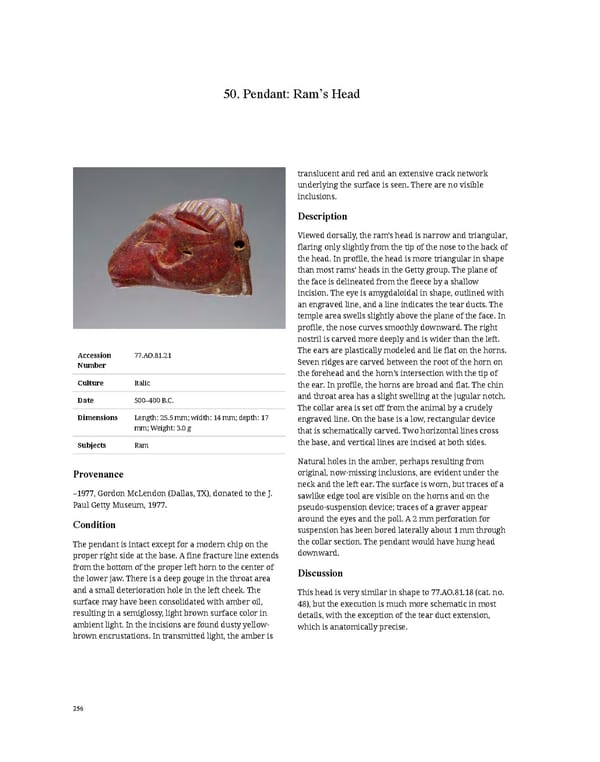50. Pendant: Ram’s Head translucent and red and an extensive crack network underlying the surface is seen. There are no visible inclusions. Description Viewed dorsally, the ram’s head is narrow and triangular, flaring only slightly from the tip of the nose to the back of the head. In profile, the head is more triangular in shape than most rams’ heads in the Getty group. The plane of the face is delineated from the fleece by a shallow incision. The eye is amygdaloidal in shape, outlined with an engraved line, and a line indicates the tear ducts. The temple area swells slightly above the plane of the face. In profile, the nose curves smoothly downward. The right nostril is carved more deeply and is wider than the left. Accession 77.AO.81.21 The ears are plastically modeled and lie flat on the horns. Number Seven ridges are carved between the root of the horn on the forehead and the horn’s intersection with the tip of Culture Italic the ear. In profile, the horns are broad and flat. The chin Date 500–400 B.C. and throat area has a slight swelling at the jugular notch. The collar area is set off from the animal by a crudely Dimensions Length: 25.5 mm; width: 14 mm; depth: 17 engraved line. On the base is a low, rectangular device mm; Weight: 3.0 g that is schematically carved. Two horizontal lines cross Subjects Ram the base, and vertical lines are incised at both sides. Natural holes in the amber, perhaps resulting from Provenance original, now-missing inclusions, are evident under the neck and the left ear. The surface is worn, but traces of a –1977, Gordon McLendon (Dallas, TX), donated to the J. sawlike edge tool are visible on the horns and on the Paul Getty Museum, 1977. pseudo-suspension device; traces of a graver appear Condition around the eyes and the poll. A 2 mm perforation for suspension has been bored laterally about 1 mm through The pendant is intact except for a modern chip on the the collar section. The pendant would have hung head proper right side at the base. A fine fracture line extends downward. from the bottom of the proper left horn to the center of Discussion the lower jaw. There is a deep gouge in the throat area and a small deterioration hole in the left cheek. The This head is very similar in shape to 77.AO.81.18 (cat. no. surface may have been consolidated with amber oil, 48), but the execution is much more schematic in most resulting in a semiglossy, light brown surface color in details, with the exception of the tear duct extension, ambient light. In the incisions are found dusty yellow- which is anatomically precise. brown encrustations. In transmitted light, the amber is 256
 Ancient Carved Ambers in the J. Paul Getty Museum Page 265 Page 267
Ancient Carved Ambers in the J. Paul Getty Museum Page 265 Page 267